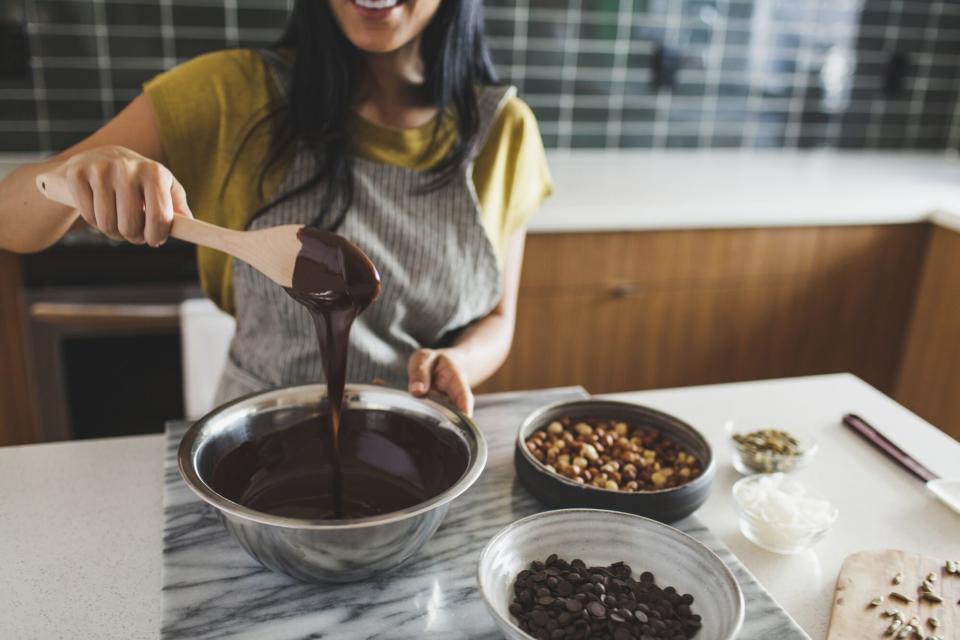Is It Safe to Cook with Wooden Spoons?
In this era of silicone this and plastic that, wooden spoons may seem old-school, but these basic tools remain essentials in our test kitchen and are still revered by chefs and home cooks alike. Here, we look at why wooden spoons are so popular and explore concerns surrounding the safety of using wooden utensils for cooking.
Related: Why It's Important to Use Liquid and Dry Measuring Cups

Cavan Images / Getty Images
Why Use Wooden Spoons?
What are the pluses of using wooden spoons? "They are comfortable in the hand, intuitive to use, and make for a uniform set," says Brandon Moore, co-founder of Lancaster Cast Iron, an American-made cookware company based in Lancaster, Pennsylvania. And Moore would know: He designs and markets his company's wooden utensils. They're also durable, yet don't scratch cookware, he adds. And they're environmentally friendly, particularly if produced by a company like Moore's, which "strives to keep [their] supply chain and partnerships as local as possible."
Meryl Feinstein, recipe developer and founder of Pasta Social Club, reaches for her wooden spoons when making risotto. "Wood is great to use and hold. It melds to your hand better and can be more comfortable," which is key when constantly stirring a dish like risotto for a long period of time.
The Downside
Keep in mind that because of its porous qualities, wood is more prone to staining (and sometimes absorbing flavors) from "strongly pigmented foods" like beets, tomato sauce, and turmeric. This is mainly an aesthetic concern. Moore suggests, "If the look [of your utensil] is important to you, it might be best to grasp an alternative tool when whipping up a berry pie filling or stirring a curry."
Are They Safe?
The short answer is yes, says Dr. Ben Chapman, a professor and food safety researcher at North Carolina State, who frequently uses wooden kitchen utensils in his own kitchen. "From a microbial standpoint, if we look at risk, we don't have any examples of wooden utensils or cutting boards leading to foodborne illnesses," he notes. Compared to plastic, metal, or silicone, there is not one material "that is safer than the others, they all come with trade-offs."
What many assume to be the drawback of wooden utensils—their porous quality—actually can work in their favor when it comes to food safety. According to Dr. Chapman, "capillary action" takes place in wood, meaning water and/or bacteria on the outside of the wooden surface essentially diffuses into the wood, "choking out" the surface bacteria and therefore not providing them with a good environment on which to grow. Additionally, wood has antimicrobial properties, since, throughout the course of evolution, plants have had to develop natural defense mechanisms to keep bacteria and parasites at bay. These properties hold true no matter what physical state the wood has been transformed into (whether it be a spoon or a cutting board).
The main food safety concern with wooden utensils, Dr. Chapman says, is not properly drying them. After washing your utensils, they need to thoroughly dry in a space where there is plenty of air flow; this should take at least 24 hours (varies based on temperature and humidity). If a utensil hasn't fully dried, it has not had the opportunity to "choke out the bacteria" and allow its antimicrobial properties to work their magic. He suggests using a drying rack for items like boards (making sure they're not stacked up against one another), and for items like spoons that might be propped upright in a utensil holder, make sure the spoon portion faces up (handle portion facing down), maximizing air flow and letting gravity draw moisture down toward the handle as it dries out.
Out with the Old
When should you replace wooden utensils? "It all comes down to making sure you're actively looking at your piece of equipment, and that it's in the same shape you expect it to be in," Dr. Chapman notes. If you notice your spoon is starting to split or is having trouble drying, or your board has grooves in it that weren't there before, it's time to think about replacing it, he advises.

